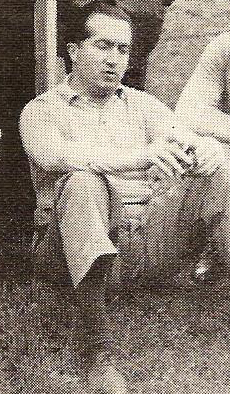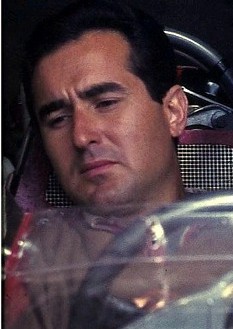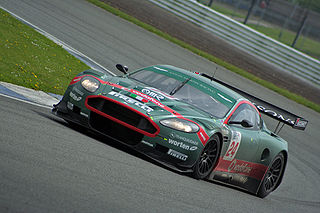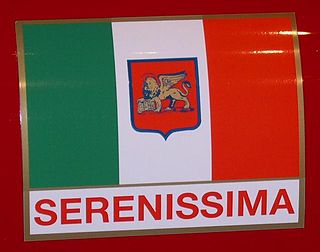Scuderia Ferrari S.p.A. is the racing division of luxury Italian auto manufacturer Ferrari and the racing team that competes in Formula One racing. The team is also known by the nickname "The Prancing Horse", in reference to their logo. It is the oldest surviving and most successful Formula One team, having competed in every world championship since the 1950 Formula One season. The team was founded by Enzo Ferrari, initially to race cars produced by Alfa Romeo. However, by 1947 Ferrari had begun building its own cars. Among its important achievements outside Formula One are winning the World Sportscar Championship, 24 Hours of Le Mans, 24 Hours of Spa, 24 Hours of Daytona, 12 Hours of Sebring, Bathurst 12 Hour, races for Grand tourer cars and racing on road courses of the Targa Florio, the Mille Miglia and the Carrera Panamericana. The team is also known for its passionate support base, known as the tifosi. The Italian Grand Prix at Monza is regarded as the team's home race.

The 1952 Formula One season was the sixth season of FIA Formula One motor racing. In comparison to previous seasons, the 1952 season consisted of a relatively small number of Formula One races, following the decision to run all the Grand Prix events counting towards the World Championship of Drivers to Formula Two regulations rather than Formula One. The Indianapolis 500, which also counted towards the World Championship, was still run to AAA regulations as in previous seasons. Since this season racing helmets were made mandatory in Formula One.

The Coppa Acerbo was an automobile race held in Italy, named after Tito Acerbo, the brother of Giacomo Acerbo, a prominent fascist politician. Following Italy's defeat in World War II, and the consequent demise of fascism, the race was renamed the Circuito di Pescara, and in some years was also referred to as the Pescara Grand Prix and 12 Hours of Pescara. The race was run between 1924 and 1961 and over the years was held to a variety of vehicle class regulations and durations. In 1957 the Pescara Grand Prix formed a round of the Formula One World Championship, a race which still holds the record as having the longest circuit length ever used for a Championship event.

Lorenzo Bandini was an Italian motor racing driver who raced in Formula One for the Scuderia Centro Sud and Ferrari teams.

Masten Gregory was an American racing driver. He raced in Formula One between 1957 and 1965, participating in 43 World Championship races, and numerous non-Championship races. He was also a successful sports car racer, winning the 1965 24 Hours of Le Mans.

BMS Scuderia Italia SpA is an Italian auto racing team founded by Italian steel magnate and motorsports enthusiast Giuseppe Lucchini in 1983. Initially named Brixia Motor Sport (BMS) the team briefly entered the World Touring Car Championship, the team's name was altered to BMS Scuderia Italia upon their entrance into Formula One in 1988. After departing Formula One in 1993, BMS Scuderia Italia has been involved in touring car racing and sports car racing.
Bellasi is a Swiss-Italian motorsport company specialized in manufacturing composite parts for racing cars. From 1970 to 1971 it was a Formula One constructor. They participated in six grands prix, entering a total of six cars.
Gilby Engineering was a British general engineering company owned by Syd Greene. Greene had lost an arm in a bicycle accident at 16 but went on to compete in many UK speed trials very successfully in the early 1950s. After he stopped competing, he fed his enthusiasm for motor racing by founding a motor racing team named after his company and later constructing the Gilby racing car. The team competed in 12 Formula One World Championship Grands Prix, including 6 with cars of their own construction, but scored no World Championship points. The Gilby cars were constructed by Syd Greene for his son Keith to drive, having previously entered a Maserati 250F for Roy Salvadori and Ivor Bueb and also a Cooper for Greene Jr. Keith Greene later became better known as a team manager in Formula One and sports car racing. Gilby made its debut in the 1954 French Grand Prix with the Maserati, for Salvadori, who also drove for the team in 1955 and 1956, and the team's last event was the 1962 Italian Grand Prix. After the team ceased competing in Formula One, the final Gilby car was purchased and entered in three events in 1963, by privateer Ian Raby. Keith Greene achieved a third-place finish in the non-championship Naples Grand Prix of 1962, with the BRM-engined car, behind the works Ferrari's of Willy Mairesse and Lorenzo Bandini.

Scuderia Centro Sud was a privateer racing team founded in Modena by Guglielmo "Mimmo" Dei and active in Formula One and sports car racing between 1956 and 1965.

Scuderia Serenissima and Scuderia SSS Republica di Venezia were names used by Giovanni Volpi to enter his own cars in Formula One and sports car racing in the early 1960s.
The 1956 World Sportscar Championship was the fourth annual FIA World Sportscar Championship. It was a contested by sportscars over a series of five races from 29 January to 12 August 1956.

Coloni Motorsport, also known as Scuderia Coloni, was an auto racing team from Italy. Formed by Enzo Coloni in 1983, the team participated in Formula Three between 1983 and 1986, before racing in Formula One as Enzo Coloni Racing Car Systems between 1987 and 1991. They made 82 attempts to take part in a Formula One race but only qualified 14 times. Since then, under the management of Enzo Coloni's son Paolo, the team has been successful in Formula Three, Formula 3000 and GP2 Series. Between 2006 and 2009 the team ran under the name of Fisichella Motor Sport, with support from Formula One driver Giancarlo Fisichella and his manager Enrico Zanarini.

The Maserati 4CL and its derived sister model the Maserati 4CLT are single-seat open-wheel Grand Prix racing cars that were designed and built by Maserati. The 4CL was introduced at the beginning of the 1939 season, as a rival to the Alfa Romeo 158 and various ERA models in the voiturette class of international Grand Prix motor racing. Although racing ceased during World War II, the 4CL was one of the front running models at the resumption of racing in the late 1940s. Experiments with two-stage supercharging and tubular chassis construction eventually led to the introduction of the revised 4CLT model in 1948. The 4CLT was steadily upgraded and updated over the following two years, resulting in the ultimate 4CLT/50 model, introduced for the inaugural year of the Formula One World Championship in 1950. In the immediate post-war period, and the first two years of the Formula One category, the 4CLT was the car of choice for many privateer entrants, leading to numerous examples being involved in most races during this period.
Enrico Platé was a motor racing driver and team manager. Although born in Italy, Platé raced, and latterly ran his racing team Scuderia Enrico Platé, under Swiss nationality. He began his career as a mechanic, but swiftly took to racing cars in addition to repairing them. His best result as a driver was fourth place in the 1938 Modena Autodrome. Although he did not achieve any notable success in the pre-World War II voiturette class, Enrico Platé became a significant and influential figure in post-war grand prix and early Formula One racing as a team owner. During his brief career in this role, Platé ran Maseratis for notable drivers such as Prince Bira, Harry Schell and fellow Swiss Toulo de Graffenried.

The Cooper T51 was a Formula One and Formula Two racing car designed by Owen Maddock and built by the Cooper Car Company for the 1959 Formula One season. The T51 earned a significant place in motor racing history when Jack Brabham drove the car to become the first driver to win the World Championship of Drivers with an engine mounted behind them, in 1959. The T51 was raced in several configurations by various entrants until 1963 and in all no less than 38 drivers were entered to drive T51s in Grand Prix races.
The 1930 Grand Prix season continued the malaise that had taken over the sport. Although there was little technical advance more privateer teams were forming, getting some factory support. The AIACR continued to mandate its fuel-regulated Formula Libre rules. Across the Atlantic, the AAA abandoned the AIACR regulations. Their new regulations were derisively called the “Junk Formula” by purists, opening up to their own version of Formula Libre: with modified stock-standard cars of up to 366 cu in (6-litres) with two seats.
Scuderia Milano was an Italian Formula One motor racing team founded in Milan by Arialdo and Emilio Ruggeri, two brothers who had raced Maseratis in the early post-war period. The team scored two World Championship points on its debut, when Felice Bonetto finished fifth at the 1950 Swiss Grand Prix.
Mario Alborghetti was an Italian motor racing driver who raced in Formula One for the Volpini-Arzani team. He was killed in an accident during his Grand Prix debut.
The Dallara F188 was a Formula One car designed by Gian Paolo Dallara and Sergio Rinland for use by the BMS Scuderia Italia team during the 1988 Formula One season. Driven by Italian Alex Caffi, it failed to score any points for the team.










